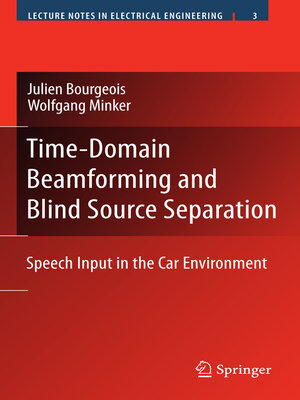Time-Domain Beamforming and Blind Source Separation
ebook ∣ Speech Input in the Car Environment · Lecture Notes in Electrical Engineering
By Julien Bourgeois

Sign up to save your library
With an OverDrive account, you can save your favorite libraries for at-a-glance information about availability. Find out more about OverDrive accounts.
Find this title in Libby, the library reading app by OverDrive.



Search for a digital library with this title
Title found at these libraries:
| Loading... |
The development of computer and telecommunication technologies led to a revolutioninthewaythatpeopleworkandcommunicatewitheachother.One of the results is that large amount of information will increasingly be held in a form that is natural for users, as speech in natural language. In the presented work, we investigate the speech signal capture problem, which includes the separation of multiple interfering speakers using microphone arrays. Adaptive beamforming is a classical approach which has been developed since the seventies. However it requires a double-talk detector (DTD) that interrupts the adaptation when the target is active, since otherwise target cancelation occurs. The fact that several speakers may be active simulta- ouslymakesthisdetectiondi?cult,andifadditionalbackgroundnoiseoccurs, even less reliable. Our proposed approaches address this separation problem using continuous, uninterrupted adaptive algorithms. The advantage seems twofold:Firstly,thealgorithmdevelopmentismuchsimplersincenodetection mechanism needs to be designed and no threshold is to be tuned. Secondly, the performance may be improved due to the adaptation during periods of double-talk. In the ?rst part of the book, we investigate a modi?cation of the widely usedNLMSalgorithm,termedImplicitLMS(ILMS),whichimplicitlyincludes an adaptation control and does not require any threshold. Experimental ev- uations reveal that ILMS mitigates the target signal cancelation substantially with the distributed microphone array. However, in the more di?cult case of the compact microphone array, this algorithm does not su?ciently reduce the target signal cancelation. In this case, more sophisticated blind source se- ration techniques (BSS) seem necessary.






